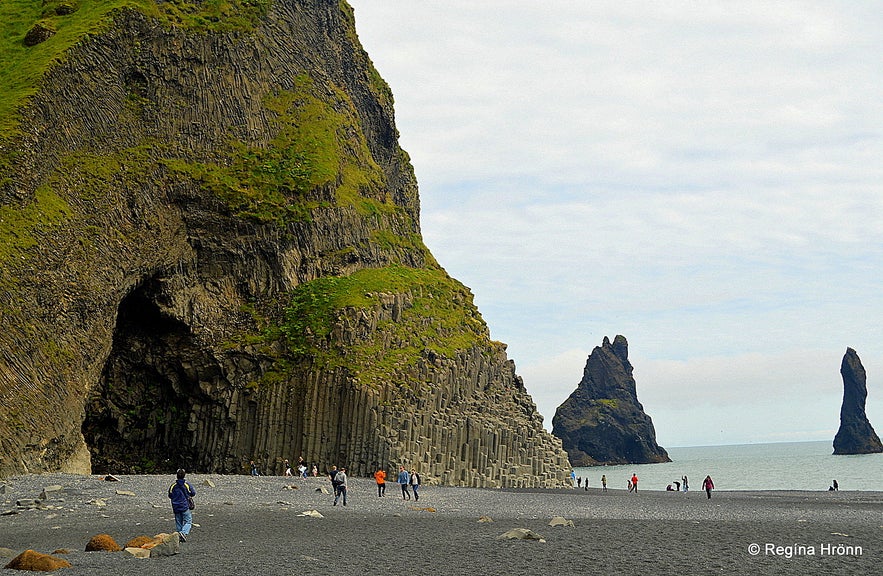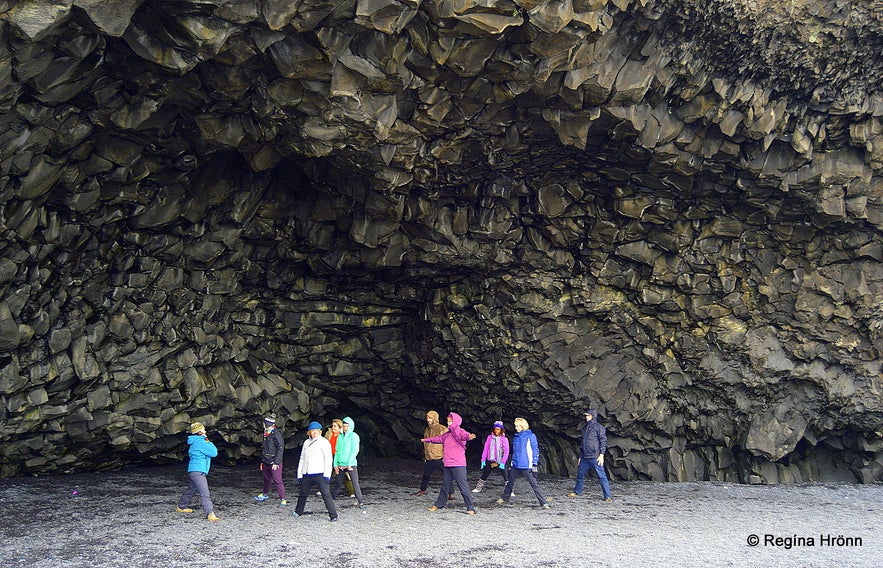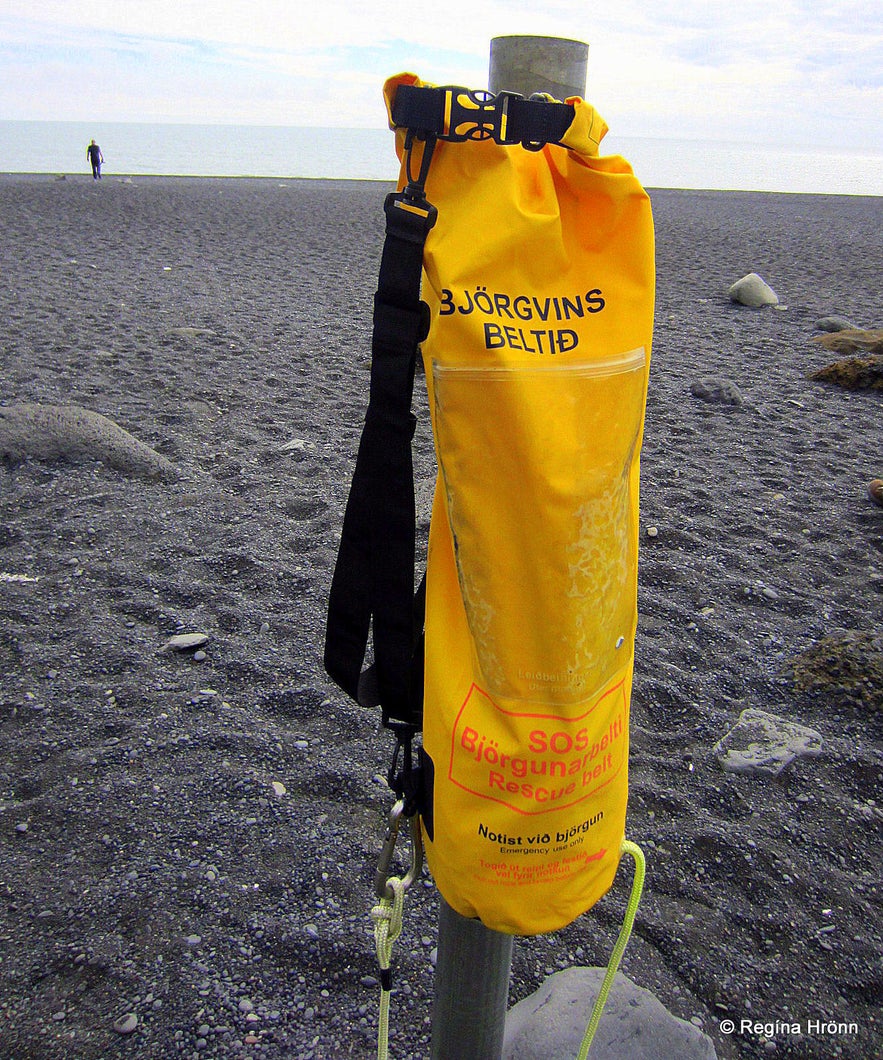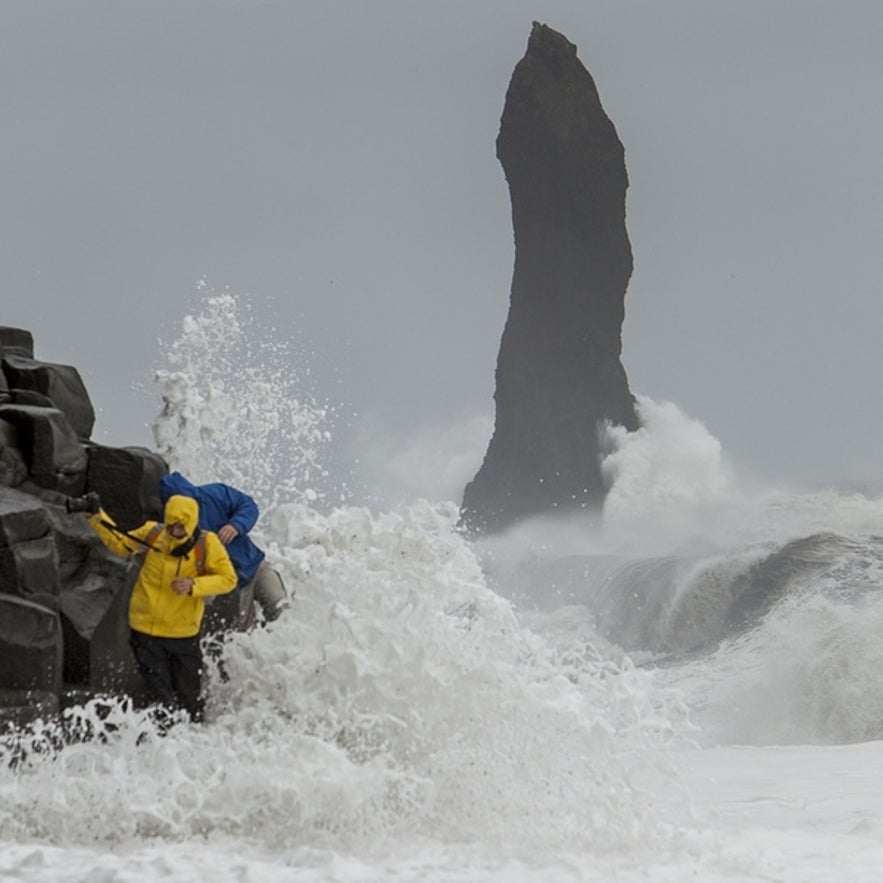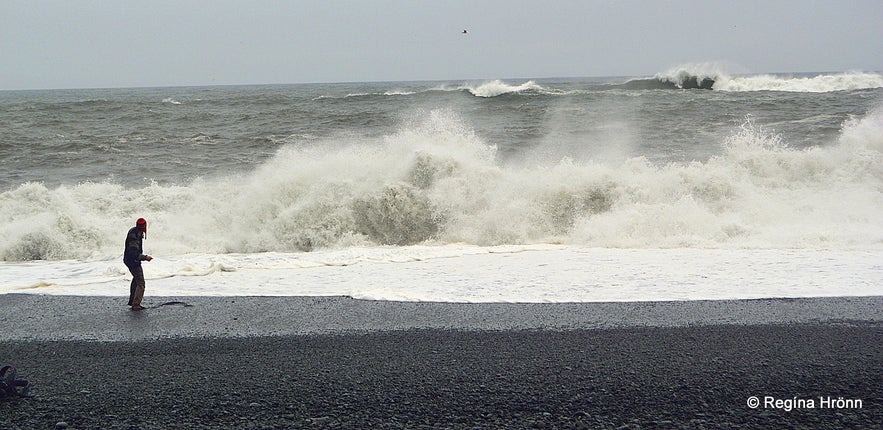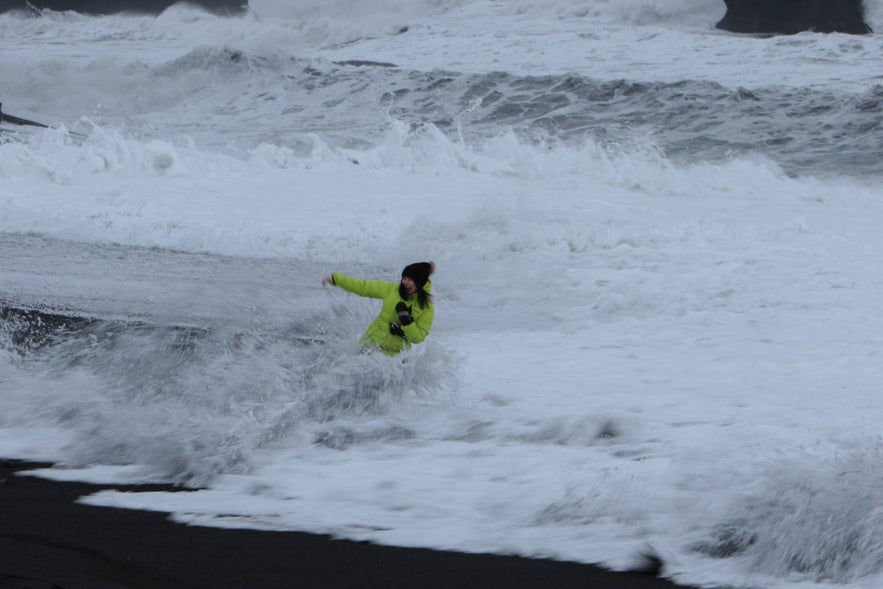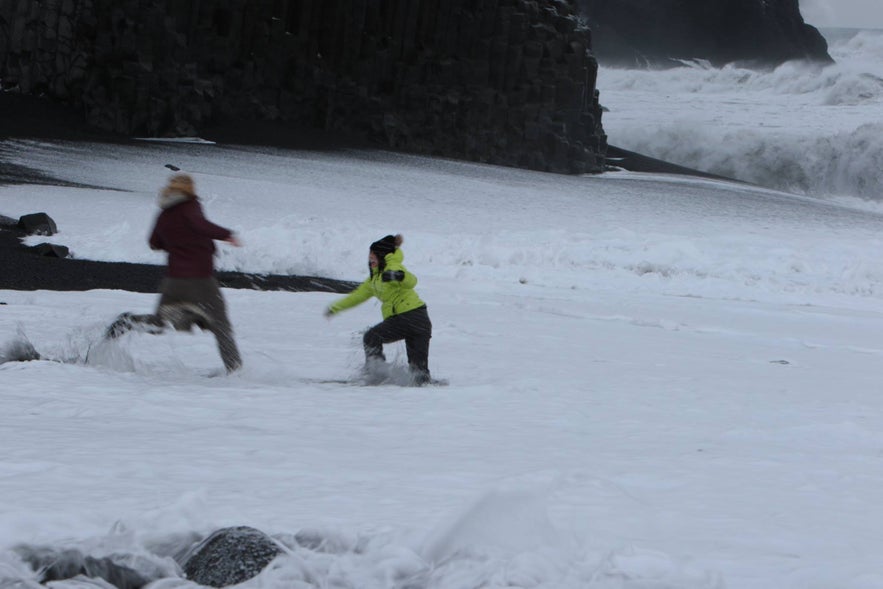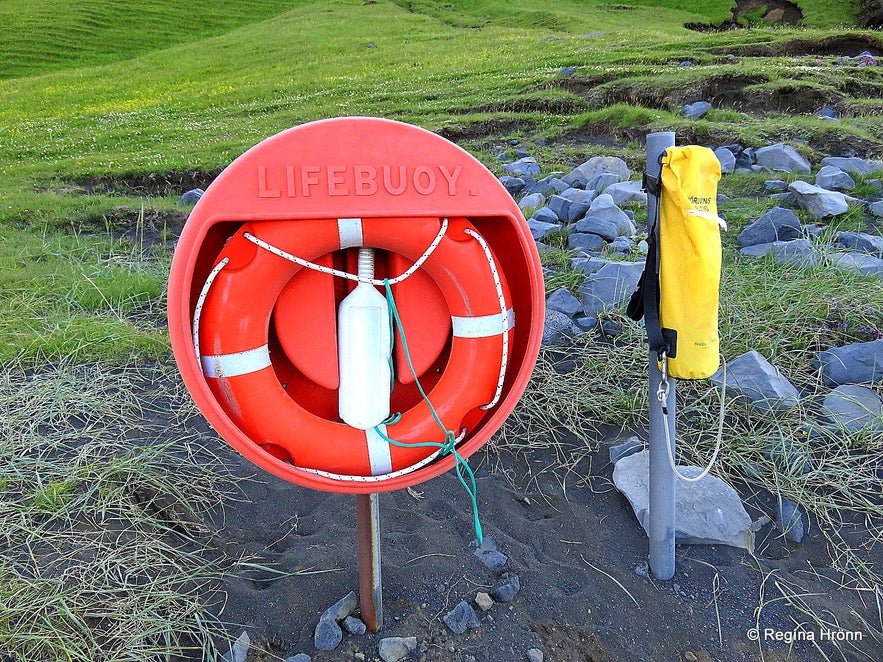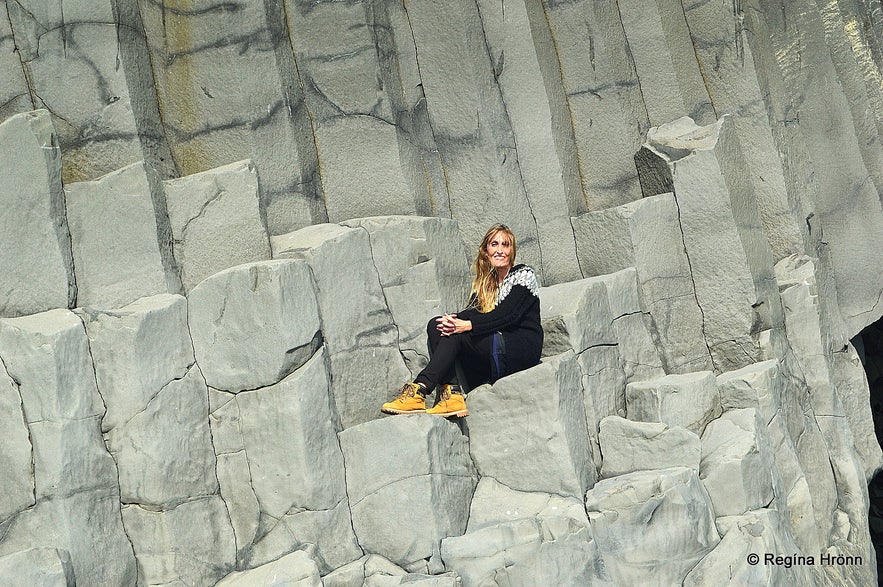
Extremely dangerous Waves by Reynisfjara and Kirkjufjara black Beaches in South-Iceland!

Yet another fatal accident took place on the 10th of June 2022 on Reynisfjara beach in South Iceland, when a foreign traveller was swept out to sea by the sneaker waves on this notorious beach. His wife got caught in the same wave but got saved.
The last fatal accident before this one took place on the 10th of November 2021, when a young Chinese woman was swept away by the sneaker waves.
Please, please be careful at Reynisfjara! I do not want to have to update my travel-blog with new fatalities like this one :(
Top photo: Kirkjufjara beach
Dyrhólaey
On the 9th of January 2017, a German woman travelling with her family was snatched by a sneaker wave at Kirkjufjara beach by Dyrhólaey.
Her husband and adolescent children had been knocked over by the waves as well but were able to save themselves in the nick of time from the undertow, which sucked this poor woman out to sea.
These accidents shake the whole nation and it sure shakes me to the core when I hear about fatal accidents on these infamous beaches, Kirkjufjara and Reynisfjara.

Reynisfjara and the basalt columns are so pretty and that is why so many people want to visit it
One elderly American lady got sucked into the sea by the sneaker waves, a.k.a. killer waves, ten years ago, back in 2007, and couldn't be saved.
I totally understand that people would want to have their photo taken or take a selfie with the waves in the background, but it is just too dangerous, so please heed my advice.
The waves here are so sneaky, they come creeping up on you and suck you in if you are standing too close - nothing can be done to save people if this happens - so please be extremely careful if you visit these beaches, and never turn your back to the sea and the waves.
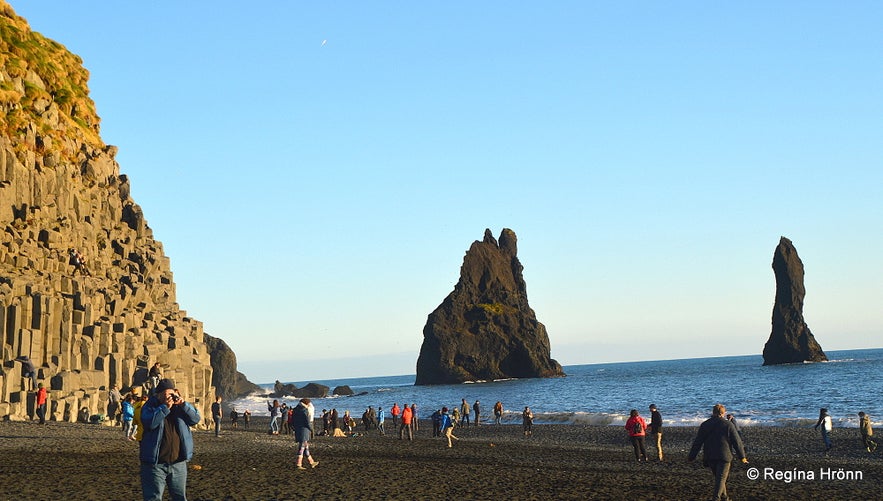
Crowds at Reynisfjara beach
Þórir Kjartansson, whom I regularly refer to, as he knows this beach and the situation here very well, said after the fatal accident in November 2021: "The reason is primarily that the sea is extremely deep very close to the shore so that the wave is almost unbroken when it reaches the beach.
The beach is steep which makes the backwash very strong.
In addition there can also be a rebound from the columnar basalt, which is very powerful and knocks everybody to the ground.
 Basalt columns by Reynisfjara beach
Basalt columns by Reynisfjara beach
On the day of one of the accidents on the beach, the conditions were very dangerous. Then there was what we old locals call northerly surf or "high-direction surf".
Such conditions are created when the wind is changing from a southerly direction to a northerly direction.
Then the sea conditions become very special. Extremely thick and high-ridged waves with long intervals go very far up the shores. Because of the distance between these wave ridges, the suction from the last "disturbance" is often fully drained before the next one arrives."
Thank you for your input, Þórir!
WATCH THIS VIDEO TO THE END! It shows exactly what you might expect to happen at Kirkjufjara and Reynisfjara.
It was shot on the beach of Porsguen near Portsall and shows what the dangerous sneaker waves are really about - the waves seem calm enough, but watch until you see what happens at minute 2!
Scary, right?!!
I have added more videos of the sneaker waves further on in my travel-blog!
Hálsanefshellir cave at Reynisfjara
There were no warning signs by Reynisfjara back then as we Icelanders know about the dangers of this beach. On the other hand, our foreign visitors don't know about the dangers here.
There was so much controversy about this and the landowners were even talking about closing Reynisfjara (on the news on 24.07.08).
Reykjavík Excursions promised to put up a big warning sign at Reynisfjara (on the news 14.09.08). Again some tourists had a close call on this beach in August 2009.
Finally, warning signs were put up.

Hálsanefshellir cave
Even though there are now warning signs by the beach, on 20.06.13 a tourist tried swimming in the dangerous sea and was in trouble for half an hour.
He was finally able to reach the shore by Hálsanefshellir cave in Reynisfjara and was stuck inside the cave and had to be rescued by the voluntary rescue team and a helicopter.
Working out in a lava cave at Reynisfjara beach
On 16.11.2013 some 100 tonnes of columnar basalt collapsed in Hálsanefshellir cave. Fortunately, nobody was in the cave at the time. Here is the story of the collapse in Hálsanefshellir.
It is in Icelandic, but there is a photo of the collapse so you can see how dangerous it would have been to be inside the cave at that time.
I am quite sure that these people (in my photo above) did not know about the collapse inside this cave. I have been inside the cave after the collapse as it is extremely beautiful, but that is a risk I took knowing about the dangers. I shouldn't have though.

By the basalt columns at Reynisfjara
People have been climbing in the basalt rocks, frightening the puffins and having to be rescued by the voluntary Icelandic rescue team - and putting up tents in this cave and on Kirkjufjara beach by Dyrhólaey. There is no waking up after that.
I also must ask people to stop climbing up to the puffins, they lay just one egg and should never be disturbed or scared like this!
There have been so many close calls on these beaches and we count our blessings when people get saved from these killer waves.

People are climbing way too high up in the basalt columns
In August 2013 there was a storm in Iceland and there were big scary waves in Reynisfjara.
Tourists were watching the waves, when a 4-5-year-old girl, who was there with her father and sister, ran towards the sea.
She got as close to the sea as possible, but as fate has it, the sea retreated and she was saved. Had the sea not retreated she would have been sucked out into it and would have drowned.
Reynisfjara beach and Reynisdrangar sea stacks
It was only a matter of minutes between life and death. A policeman and a tour guide, Páll Jónsson, who was on the beach, were able to grab the girl before the next wave would have grabbed her.
I was so sad when I read this on the news, why don't people read the warning signs and put their children and themselves in danger like this?!!
What can we Icelanders do to spread the word about the dangers of this beautiful yet infamous beach in Iceland?
Björgvinsbeltið life belt at Reynisfjara
I got these suggestions from Mary Stewart from Daytona Beach, Florida:
"1. Have a guard gate where a small entrance fee is charged and people are told not to get close to the water or turn their back on it.
2. Change the signage so it has more of an immediate impact. A huge DANGER sign in bold red letters would be better. Other languages could be shown at the bottom of it but I would put the main word in English and have it written much smaller but still readable along the bottom of that sign.
3. Either hire a guard who makes people get away from the water or have them sign waivers right before they step on the beach whether it be at the entrance station, or on their tour bus right before they are allowed off of it. The entry fee could actually pay for a guard."
Thank you very much for your input; Mary!
Photo credit: Finnbogi Marínósson
I regularly see photos and videos of people putting themselves in danger on these beaches and this seems to be endless. I
n 2015 a tourist was standing in the waves taking photos, even though locals were yelling at him to get out of there.
This happens almost daily now and the tour guides are growing tired of yelling at people and not being listened to.
I added a photo above shot by Finnbogi Marínósson of tourists in grave danger in Reynisfjara on 16.05.2015. Finnbogi allowed me to use his photo for my blog so that we can reach out to more people and warn them of the dangers on this beach. Finnbogi said on the news that a couple with 2 toddlers had been letting the toddlers follow the waves!
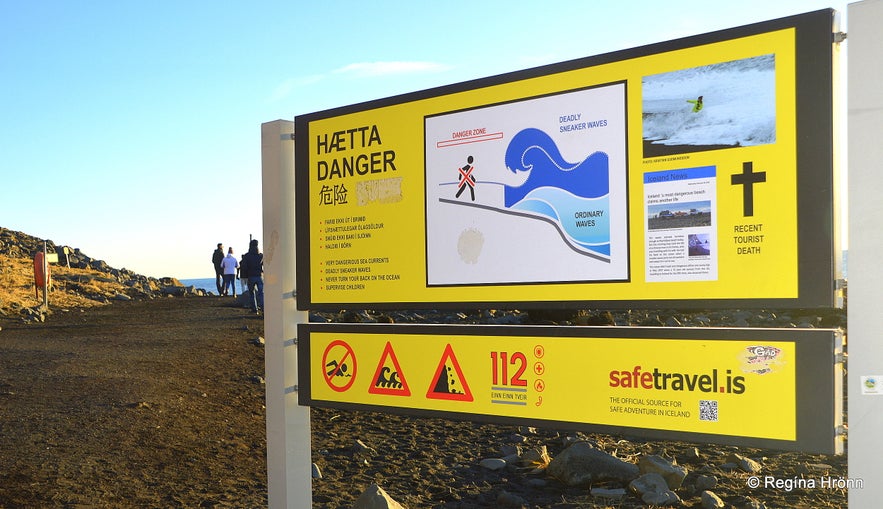
Warning signs at Reynisfjara
Something needs to be done here to make people aware of this danger, I don't think people read the warning sign and might think it is only an information sign.
But somehow they come to know about Reynisfjara, be it through photos on the Internet or travel websites.
So a word of warning should always be added when introducing photos or writing about Reynisfjara.
 The new warning sign warns of the dangers with green, yellow, and red warning lines
The new warning sign warns of the dangers with green, yellow, and red warning lines
Nobody would put themselves or their children at risk on purpose like this, so the fault lies in the lack of information somehow.
People follow the waves and then run away from them laughing like this is a sort of game - playing with death. It used to irritate me so much watching this kind of behaviour.
Defying the waves at Reynisfjara beach
I took the photo above on one of my visits to Reynisfjara - this man was also playing the dangerous game of letting the waves follow him, obviously unaware of the danger of sneaker waves in Reynisfjara.
The staff at Svarta fjaran - the Black Beach restaurant by Reynisfjara, say that they often go down to the beach to warn people against playing in the waves, only to be sneered at and scolded for trying to ruin the holiday of these people!
Not so, they are actually trying to save their lives as it is very difficult for them to watch people putting their lives at risk. 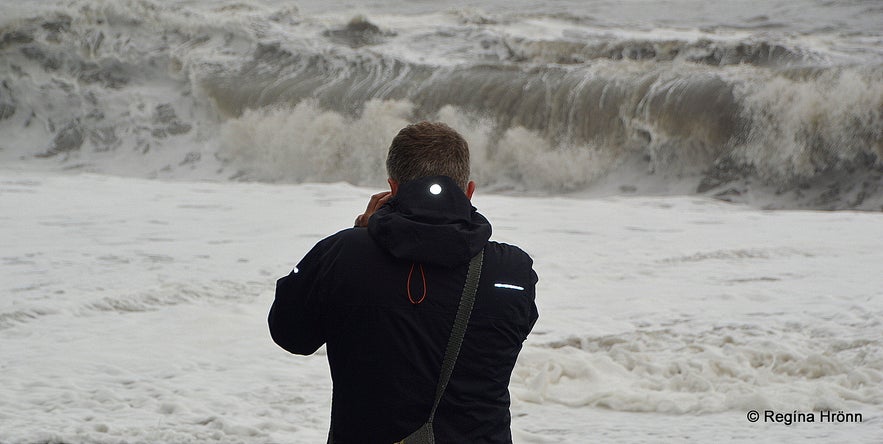
A friend of mine at Reynisfjara beach, he kept a safe distance
I regard it as my duty to warn our foreign visitors about this danger and of other dangers in my country. Sometimes they listen to me, sometimes they don't - and believe me, it is very frustrating when they don't listen.
A video shot by Erica Mengouchian shows vividly how dangerous it can be to turn your back to the waves. Please watch it - a group of people got caught in the waves.
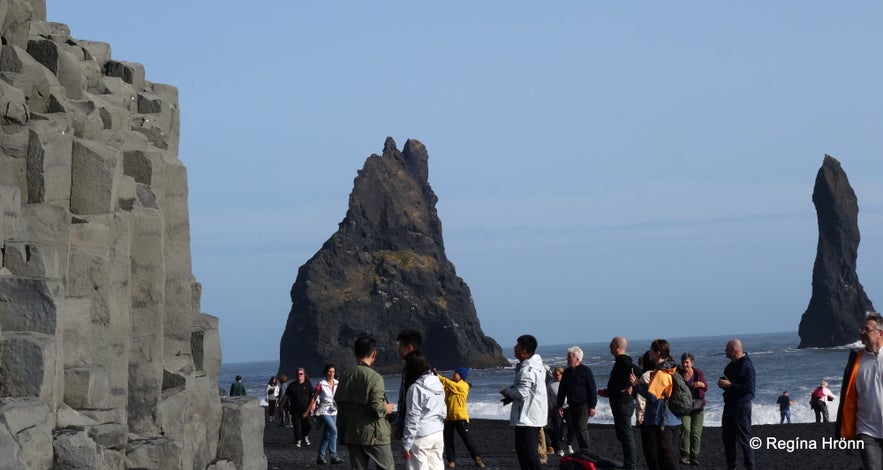 This part of the beach was off-limits, yet it was filled with visitors
This part of the beach was off-limits, yet it was filled with visitors
I also want to ask you to read one article titled It's been a year since I almost died in which Kathy Kiely describes her near-death experience when the waves in Reynisfjara threw her into the cave and sucked her out again.
It is amazing that she stayed alive.
On 1.2.2016 a tourist didn't listen to warnings and got too close to the sea and the waves caught her. It was impossible for her to stand up and save herself (see the photo below).
Photo credit: Kristján Guðmundsson
People ran to her help and thus put themselves in danger, but they managed to save her life. She was not the first and not the only one to get caught in the waves on this day in February and even people, who had watched this woman get caught in the waves, later on, got caught in waves in the same location!
Kristján Guðmundsson, coach-driver, took the photos I have added here with his permission. Kristján used the zoom on his camera to get these photos and could not do anything to help this woman as he was too far away.
We are all eager for this to stop so we wish for the photos we take to be spread around until our foreign visitors understand the grave danger of the killer waves on this beach.
Photo credit: Kristján Guðmundsson
I shudder at the thought of myself in this situation, not being able to save myself, and feel the undertow dragging me out to sea. Please don't let it happen to you!
In February 2016 yet another FATAL accident happened in Reynisfjara. A Chinese man had stood on a 50 cm high freestanding basalt column in front of the beautiful wall of basalt columns (see my photo below) taking photos with his back turned away from the sea.
The waves hit him and dragged him into the sea where he drowned :(
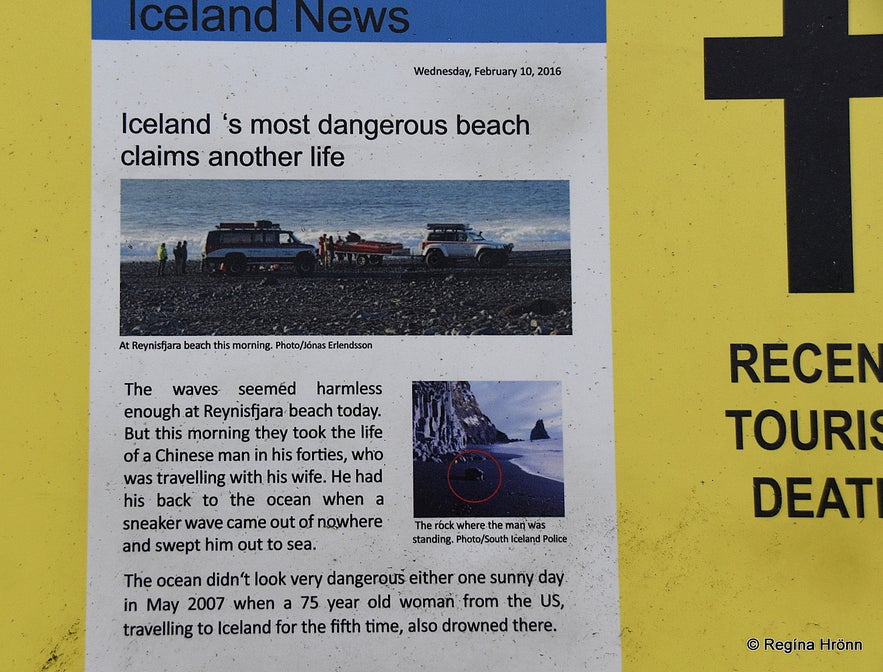
The warning sign at Reynisfjara beach
He was in Iceland with his wife - I cannot even begin to imagine what his wife must have felt like when this was happening.
Just a couple of hours later tourists were still playing in the waves, even though they had been informed about the fatal accident. What can be done?
After the fatal accident in February 2016, the police guarded the beach for 2 weeks. But despite warnings of immediate danger people seemed to flock to the beach and get caught in the waves. We don't really know what to do to keep people safe on this beach.
The beautiful basalt columns at Reynisfjara beach
This is causing us Icelanders a lot of worries as so many tourists are visiting Iceland now and they just don't seem to use their common sense when visiting Reynisfjara beach.
New graphic danger signs have been put up, as people were paying no attention to the old ones and just passing them without even looking at them.
Now it seems like these graphic signs are not even catching the attention of our foreign visitors and we Icelanders don't know what we can do to prevent more deaths here on these beaches.
The warning sign at Reynisfjara beach
Should the signs be bigger and more graphic? And should we put up more than 2 warning signs?
The best idea I have heard is to put blinking lights on the warning signs to attract attention to them. I support flashing lights being put up here.
In November 2022 blinking signs were finally put up, and I hope that people will notice them before visiting the beach.
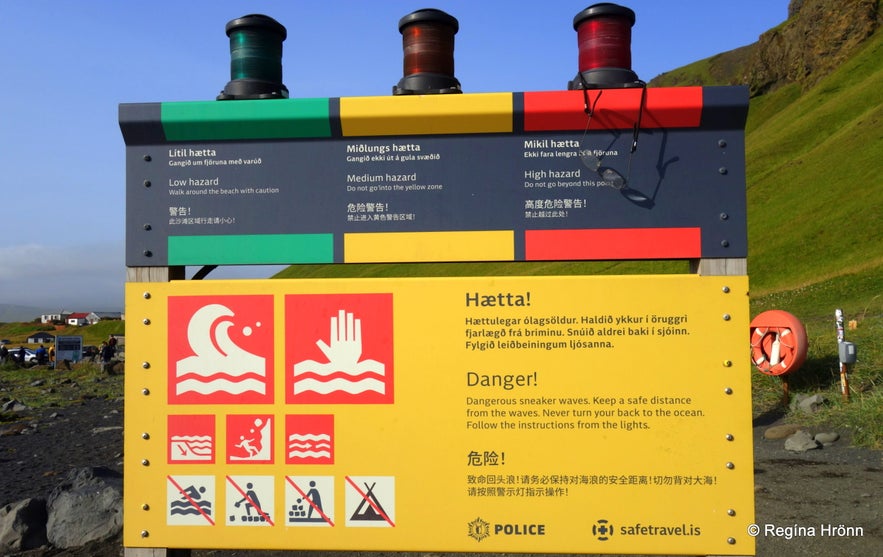 The new warning signs - the yellow light was blinking during my last visit
The new warning signs - the yellow light was blinking during my last visit
The warning lights are green, yellow, and red and show how dangerous the waves are. Maybe the path should lead to the warning lights and then to the beach to make sure that people notice them.
During my last visit the yellow sign was blinking, but it was sunny, and not many people took notice of them. But while I was taking photos of the sign a couple of people noticed the yellow light and checked out how far they were allowed to go before they reached the yellow warning line.
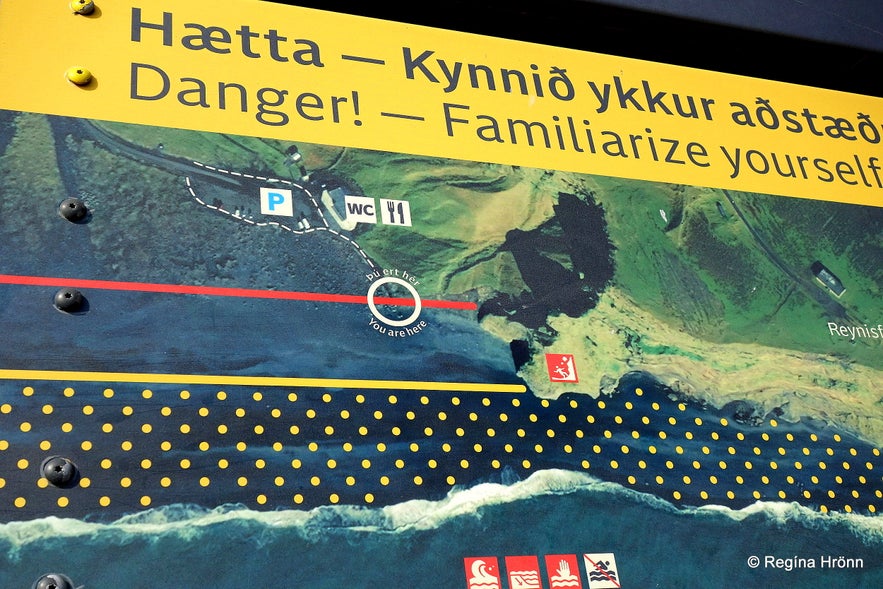 Here you can see the yellow line and dots which are off-limits when the yellow light is blinking
Here you can see the yellow line and dots which are off-limits when the yellow light is blinking
I know I have said this before, but I must reiterate, don't turn your back to the sea and stay at a safe distance from it - and even if you think you are safe, then go a little further away.
But, even though the yellow light was blinking there were some people down by the sea photographing their children wading into the sea!!
Stay higher up than the wet sand, as sneaker waves go higher than the last waves.
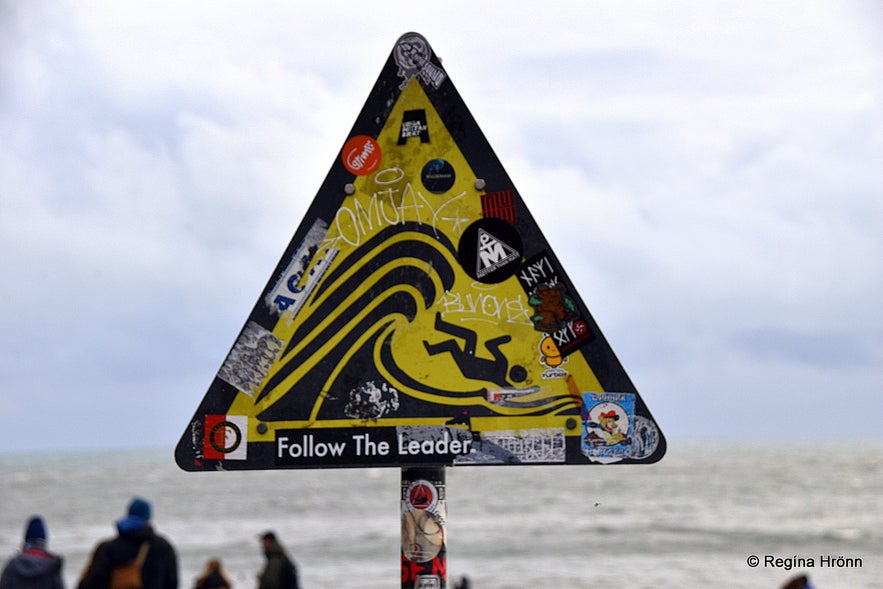 Why are some people putting stickers on this danger sign??
Why are some people putting stickers on this danger sign??
It is better to be safe than sorry, I think. This is the cold and rough North-Atlantic Sea, which is nothing like the Adriatic Sea or the Mediterranean Sea.
We have had foreign visitors who have wanted to jump into the waves as they remind them of the waves in the sea in their homeland.
Our tour guides have had to battle with people who have wanted to take a dip in the dangerous sea by Reynisfjara, and who have run towards the waves as soon as the tour guides turn their heads! They claim to be very strong swimmers and that this sea could not harm them, sic!
The life buoy at Reynisfjara beach
This is so very sad and we don't want this happening to anybody else. So please stay safe if you visit this beach, the waves come unexpectedly and drag you into the ice-cold sea if you are not on your guard.
I got permission from Mirella-Marie Katarina Radman, to publish her story in my travel-blog, but she told me about her experience at Reynisfjara in a comment under my travel-blog when we posted it on the Facebook page of Guide to Iceland. It is a must-read:
"I profess I was one of those stupid people who ran out to the sea with great delight. In June 2016, on a very windy but beautiful day, I visited this beach with an Icelandic Photographer and Tour Leader friend, Thorsten Henn. If it were not for his repeated and angry warnings, I tell you I would have rushed into the sea for a dip. In fact, I tried the first chance I got.
The waves were not even high that day. Thorsten was very angry with me as he had warned me numerous times while in the car not to stray too far away from him, that the weather conditions change quite quickly. Of course, I did not listen to him. When we arrived at the beach we separated for a few minutes as he went to the only hospitality cafe on the beach.
Reynisfjara beach
Once I was out of his site I made a bold dash for the water. I was about three or five metres from the shoreline -- shoes and socks off -- when I was grabbed by another Icelandic tour guide leader who scolded me for my stupidity and reiterated that I was endangering my life.
I had run past this other tour guide who yelled after me: "Where the hell do you think you are going (in English)?" and had completely ignored him, as I was obsessed with the idea of swimming in the sea and seeing a puffin up close.
The tour guides all know one another and I got a royal and well-deserved telling off. Back at the cafe, I was terrified of telling Thorsten but figured I had better before he heard from others. Of course, he exploded on me and the day was ruined. I deserved every expletive directed at me.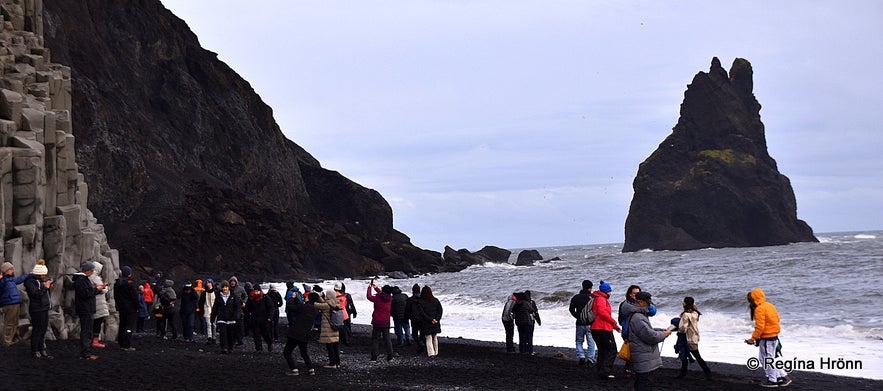
Crowds at Reynisfjara beach
During the car ride back to Reykjavik I apologized and he did as well. He told me he was angry because, with 10+ years of experience leading tours across Iceland, people of all shapes and sizes think they are stronger than the elements and Mother Nature, until catastrophe strikes. I argued I was from Croatia and a very strong swimmer.
He told me: "No Katarina. This is not the Adriatic Sea but the North Atlantic Ocean for God's sake! You are endangering not just your own life but that of Iceland's rescue crews as well!"
Of course he was right and of course, I was impulsive and stupid. Looking back, I shudder to think what would have happened if the other tour guide had not picked me up and plucked me away from harm. Now, whenever I visit Iceland I am thoroughly conscientious and respectful of all the do's and don'ts.
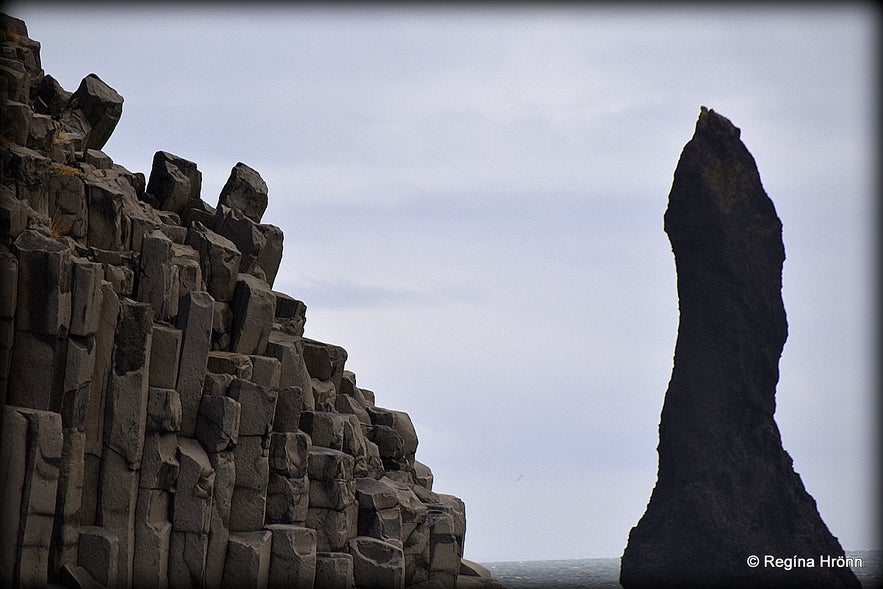
Basalt columns and sea stacks at Reynisfjara beach
Please, dear tourists, visit and enjoy this beautiful Wonderland of a country, but respect the signs as a courtesy and a way of ensuring that Mother Nature stays untouched by our human footprint and selfish selfie-obsessed tactics. If you don't it's just too high a price to pay".
Thank you for your story, Mirella-Marie, it is a very important input to our endeavor to save lives on Reynisfjara beach.
Here is another story: It’s been a year since I almost died
A map of Reynisfjara beach
Through the years I have taken notes of the fatal accidents and close calls at Reynisfjara and Kirkjufjara for a travel-blog about the dangers on these beaches, which is why I had the exact dates written down. But it was not until now that the German lady drowned and I watched a really frightful video shot by Þórir Kjartansson, one of the previous owners of Hjörleifshöfði, that I knew it was time to write this long-overdue travel-blog. Þórir's short video completely shocked me.
The video shows an Asian family with their small children at Kirkjufjara beach photographing one of their children. The 6-year-old child is so close to the treacherous waves, which were extremely dangerous on this particular day, that I wonder how the parents thought this could be safe, even if they were not aware of the danger of this particular beach.
Þórir shot the video from a distance, but when he saw that a sneaker wave was reaching the child he immediately ran to its help! When he explained to the parents that their child was about to be sucked into the sea and there was no rescue after that, they got a shock.
That the parents got a shock made me realize that they had no idea that their child was in any immediate danger!
To us Icelanders watching the video, it was so obvious, so it makes me wonder what the difference is between us Icelanders and the foreign tourists in question.
We live here and are taught from very early in life about the many dangers in Iceland. Do these people come from the city and have not seen the sea before?
Or do they know the sea but are not aware of how dangerous it can be here in Iceland?
The Kirkjufjara sign with warnings
Note that I am just trying to find out what is happening on this beach so that we can prevent more deaths here. Had they read the warning signs and known about the dangerous waves here?
Or did they miss the signs and had no idea that they were in danger? As on this very same day the German lady drowned on this beach.
The video above was taken from Lágey of Kirkjufjara beach in the fall of 2021. The beach is closed off now and nobody goes there anymore.
People of all nationalities seem to put themselves in danger on this beach, so it has nothing to do with where they are from, but rather human nature. So we need to find out what we have to do to prevent this from happening.
I think big, very graphic signs would be helpful. If I were to go to a beach and saw photos of people in trouble in the waves and photos of people who have drowned on the beach, I would think twice before putting myself in danger there.
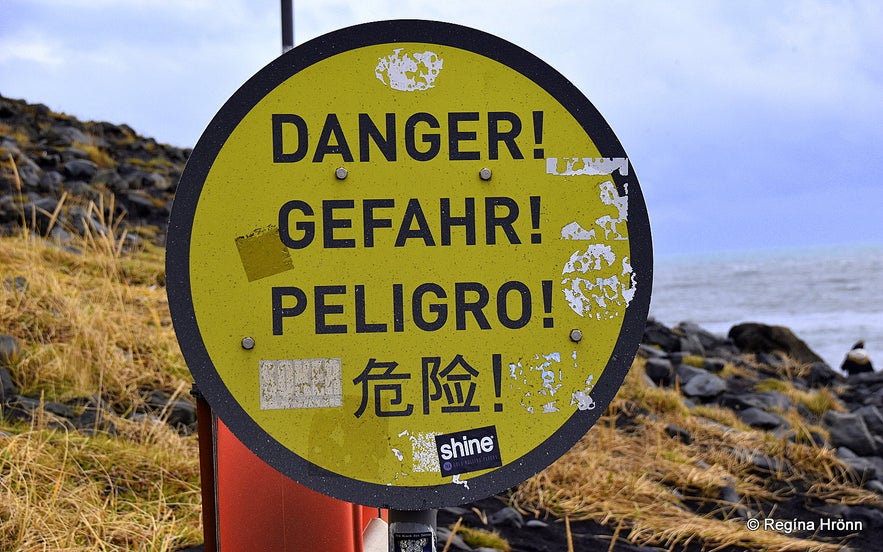
One of the danger signs - and the stickers again??
Jónína Sólborg Þórisdóttir, the daughter of Þórir Kjartansson, who shot the video above, allowed me to add to my travel-blog her explanation of why the waves are so dangerous here on this particular beach. The father and daughter are so very knowledgeable about this area, being born and raised here:
"The continental shelf at Reynisfjara and Kirkjufjara beaches are very steep and close to the shore so the tidal waves only break maybe once or twice when they're coming up to the shore (which creates these very unexpected, big, and sudden waves). This is not the case at Víkurfjara so the beach in Vík is completely different and not nearly as dangerous as the waves break several times before they reach the shore.
But the other day when the German woman passed away, the wind was sort of suddenly turning from southern winds to northern winds and that, in combination with the steep shelf, probably contributed greatly to how the tidal waves behaved on that particular day".
Thank you very much for your input, Jónína :)
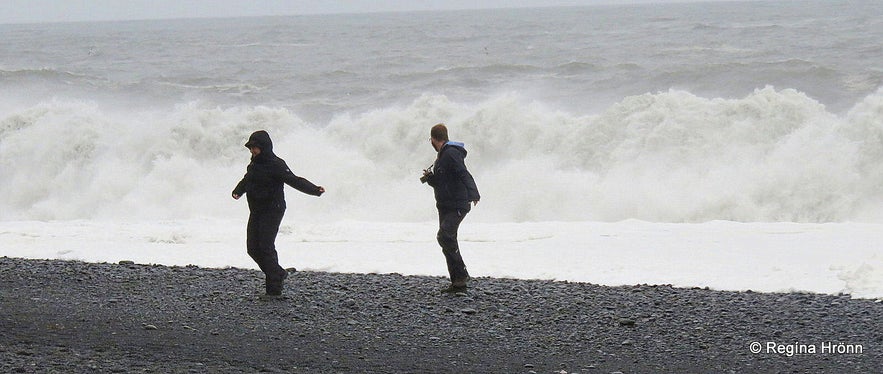
Reynisfjara beach
Tour guides warn their group about the dangers, but when the group comes to the beach the tourists seem to scatter around the beach and forget about the warnings.
If you visit Reynisfjara beach on a guided tour, which I would recommend, then stick by the tour guide and other members of the group.
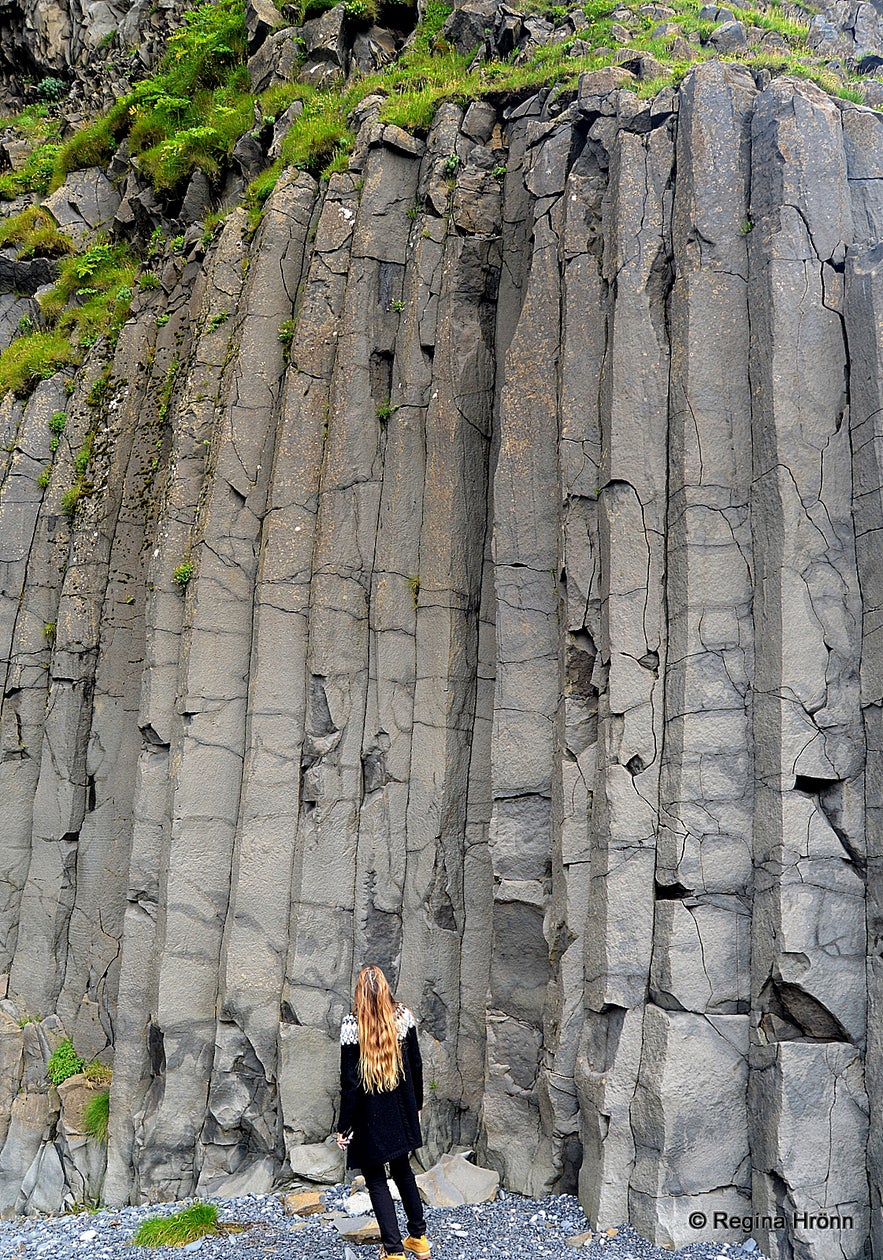
There are many photo opportunities at Reynisfjara - beware of the waves while taking photos
We thought that people were just behaving recklessly to get the right photo, but now I realize that they don't know about the danger or don't realize that they are in grave danger.
They are not to blame, so we locals have to do something to stop them from harming themselves.
A video on sneaker waves was pointed out to me, which I am going to add here before I finish up. This video was shot by Steve Raplee in Coos Bay, Oregon, USA.
It is advisable to read these news articles on Mbl.is before visiting Reynisfjara and Kirkjufjara beaches:
Reckless behaviour to get the right photo.
Reynisfjara beach death: Woman was pulled down by a wave and sucked along in undertow.
Beach closed at Kirkjufjara following yesterday's tragedy.
The woman who defied death with a smile on her face (in Icelandic, but contains a series of photos depicting the dangers of the waves)
... and many, many more news articles, where you will see photos of people getting caught in these dangerous waves and get more information on Reynisfjara and Kirkjufjara beaches.
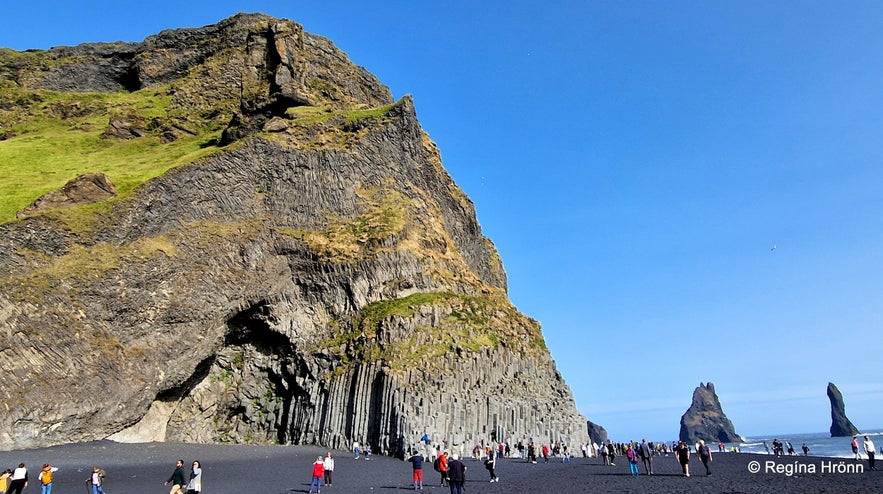 A beautiful sunny day at Reynisfjara in 2023
A beautiful sunny day at Reynisfjara in 2023
Kirkjufjara was closed after the last death on the beach, but some people crossed the police banner to visit the beach!! This is so incomprehensible, and we are at a loss about what to do to keep our visitors safe :(
On the 19th and 20th of August 2019, a large landslide fell from Mt. Reynisfjall and onto the beach below.
Reynisfjara was closed by a police banner and people seemed to respect that closure, as they could see the huge landslide with their own eyes and understand how dangerous it would be to cross the banner.
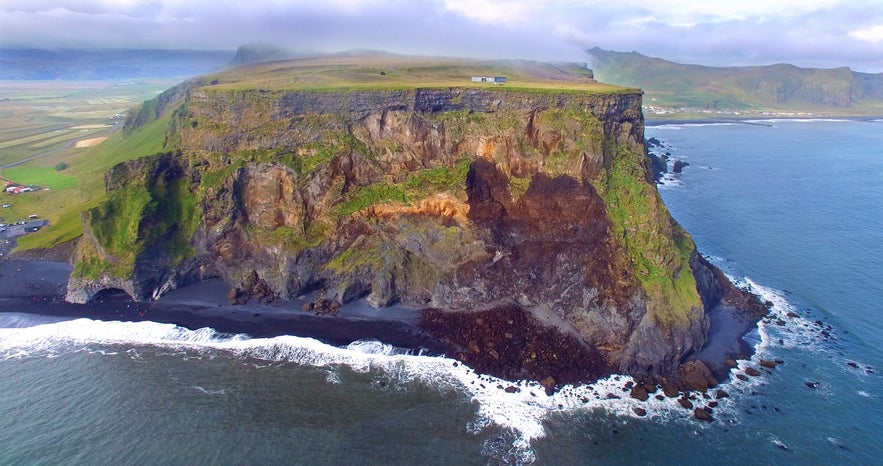
Photo by one of the landowners, Þórir Kjartansson, which he most graciously allowed me to use to warn visitors about the immediate danger
That was only in the beginning though and now the police and landowners are frustrated at the sight of tourists crossing the police banner and standing in the danger zone beneath the landslide.
More landslides with tonnes of rocks and mud can be expected so please stay away and be safe! NOW THE EASTERN PART OF THE REYNISFJARA BEACH HAS BEEN CLOSED OFF PERMANENTLY.
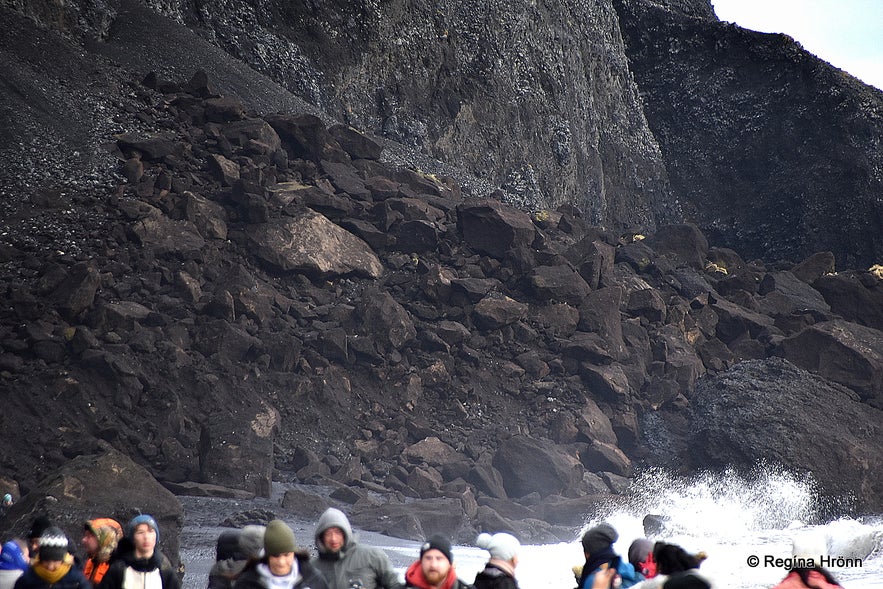
From my visit in October 2019 - you can see how huge the landslide is
You can read about the landslide in the English version of Morgunblaðið newspaper - Iceland Monitor: Landslide on Reynisfjara beach.
Now, the latest video I watched from Reynisfjara is scary, to say the least. In November 2019 during bad weather, the waves reached very high!
https://www.facebook.com/thorolfurs/posts/10157696933817937
The video was posted on Facebook by an Icelandic tour guide and one of his passengers took the video of people getting caught by the waves.
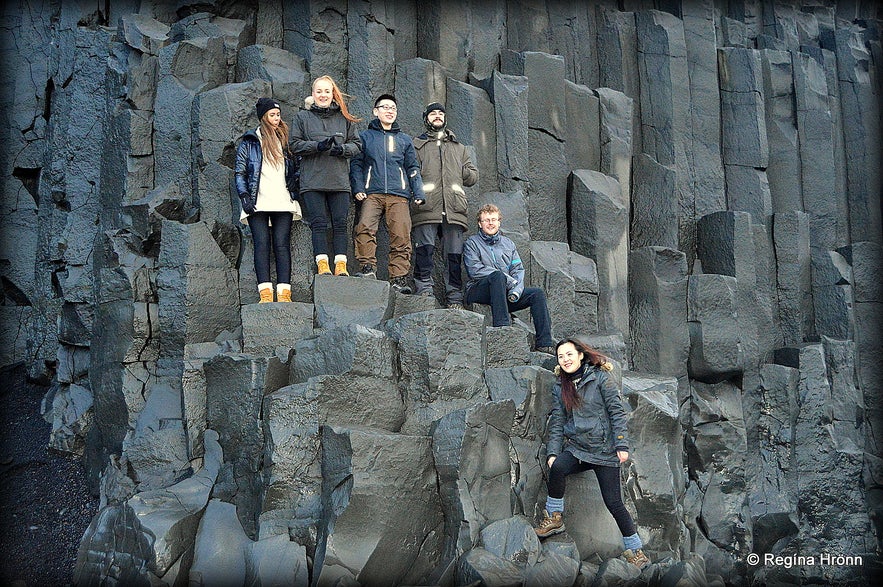
The staff at the office of Guide to Iceland visiting the beach on a rainy day in January 2016
Again, in February 2020 two young children were saved by a tour guide when a big wave reached them, slammed them down, and was about to suck them out to sea with their faces underwater.
Their parents stood petrified, so the tour guide, knowing what was about to happen, risked his own life by jumping into the waves to save the children.
See also: Risk Assessed on Reynisfjara: Children Rescued Last Weekend on Iceland Monitor.
Do not let this happen to your kids and hold on to them while visiting this beach!!
And in May 2022 a Spanish tourist almost drowned when he deliberately went swimming in the dangerous waves by Reynisfjara.
Also, may I ask you not to climb any higher on the basalt columns than I do here. I am sitting low but it still makes for a good photo
Before visiting Iceland please also read safety instructions on safetravel.is - it can save your life in Iceland. And remember that even though Reynisfjara beach is so beautiful with all the basalt columns and Reynisdrangar pillars of rock, then it is one of the most dangerous beaches in Iceland.
An important read before you visit Iceland: Things That Can Kill You in Iceland
I have written another travel-blog about Dyrhólaey: Cape Dyrhólaey in South Iceland - the One with the big Arch
Please stay safe in my country!
Andere interessante blogs
Noorderlicht in Ijsland
Als je nog nooit de kans hebt gehad om een ‘noorderlicht-show’ te zien en het één van je dromen is, dan is een reis naar Ijsland in de winter een echte aanrader. Het is geen garantie maar de kans beLees verderReizen naar IJsland per boot
Ik ben eind mei 2017 naar IJsland geemigreerd en ben met mijn eigen auto en de boot gegaan. Wat mij opviel is dat hierover heel erg weinig te vinden is qua reizigers ervaringen. Vandaar dat ik heb besLees verderGeitenboerderij Háafell
Ik geef het eerlijk toe, ik wist tot 2 jaar geleden ook niet van het bestaan van de IJslandse geit af. Totdat ik hoorde dat er 200 geiten op de nominatie stonden om geslacht te worden omdat in IJslandLees verder

Download het grootste reisagentschap van IJsland op je telefoon en beheer je hele reis op één plek
Scan deze QR-code met de camera van je telefoon en klik op de link om het grootste reisagentschap van IJsland in je zak te stoppen. Voeg je telefoonnummer of e-mailadres toe om een sms of e-mail te ontvangen met de downloadlink.


